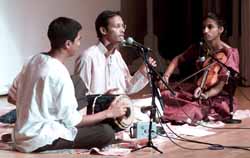Indian groups host Carnatic concert
Carnatic music, a type of music more than six centuries old from the southern regions of India, was performed Friday by three musicians at Utah State University.
Two of them – one from Berkeley, Calif., the other from Salt Lake City – came to USU to accompany Shyam Kumar, a graduate student studying electrical engineering, as he sang during the Consortium for Indian Culture’s inaugural ceremony.
The concert, which was sponsored by the CIC and the Indian Students Association, featured Kumar with Prashant Subbarao on the mridangam (a type of drum) and Divya Ramachandran on the violin. Subbarao is a student at the University of California Berkeley and Ramachandran is a student at the University of Utah.
Kumar said the three didn’t practice together before the concert.
“I will sing,” he said. “They will create music.”
The two accompanists arrived just in time to change into tradition Indian dress and set up their instruments.
Kumar explained Carnatic music as India’s classical music. They were singing in the 12th and 13th centuries, he said, but the notes and accents were never formulated into music until the 14th century.
The person who formulated the music was Parandara Dasa, called the godfather of music in India, Kumar said. Four centuries later, India had three great composers – the Music Trinity. Between the trinity and Dasa, more than a million songs were composed.
Ram Swaminathan, CIC’s president, said this is the first time a concert like this has been performed on campus.
“We’re making a more consistent effort to bring [Indian] culture to Loganites – and the university,” Swaminathan said.
He said CIC, the newest of the two campus Indian organizations, hopes to bring more of Indian culture to the community through lectures, presentations, workshops and concerts such as Friday’s.
“Such an effort like this has never been taken before,” he said.
Bala Ganesan, a doctoral student in nutrition and food sciences and member of CIC and ISA, also said he hopes Indian awareness will expand by the two CIC promoting events such as those Swaminathan mentioned and other activities, such as religion and philosophy forums and presentations about Indian dress and art.
While ISA helps to make Indian students feel more at home at USU, Ganesan said CIC will be more of a cross-counter cultural organization – connecting the Indian community more with other organizations.
“We are all busy,” he said. “One [group] might not be sufficient for everyone’s needs.”
The three musicians sat cross-legged on a blanket throughout the concert on the stage of the Taggart Student Center Auditorium. The three watched one another closely while improvising their music to harmonize with the other two.
Ramachandran played the violin in what Kumar called the “classical Indian style,” with the end of the neck (scroll) resting on her knee, and the other end (that normally rests on the shoulder) leaning against her collarbone.
The concert garnered students and faculty from all different arenas. Indian students, faculty and community members were joined by non-Indian students and faculty.
“It was fun to get a taste of the Indian music culture,” said senior Eric Westover, who’s majoring in graphic design.
Juan Franco, vice president of Student Services at USU, said he hadn’t planned on attending, but heard the music from his office and was interested.
“I was pleasantly surprised,” he said. “One thing we press is to bring more cultural activities to campus.”
Steve Jenson, director of Housing and Food Services, said he appreciated the diversity Indian students bring to campus and their “academic vibrance.”
Kumar said he has been singing for 20 years, and made his first debut at age 12. He sang in five different languages Friday night – all Indian dialects.
-emilieholmes@cc.usu.edu

Shyam Kumar, (middle), is accompanied by Prashant Subbarao (left) on the mridangam and Divya Ramachandran on the violin Friday night. (Photo by Michael Sharp)

